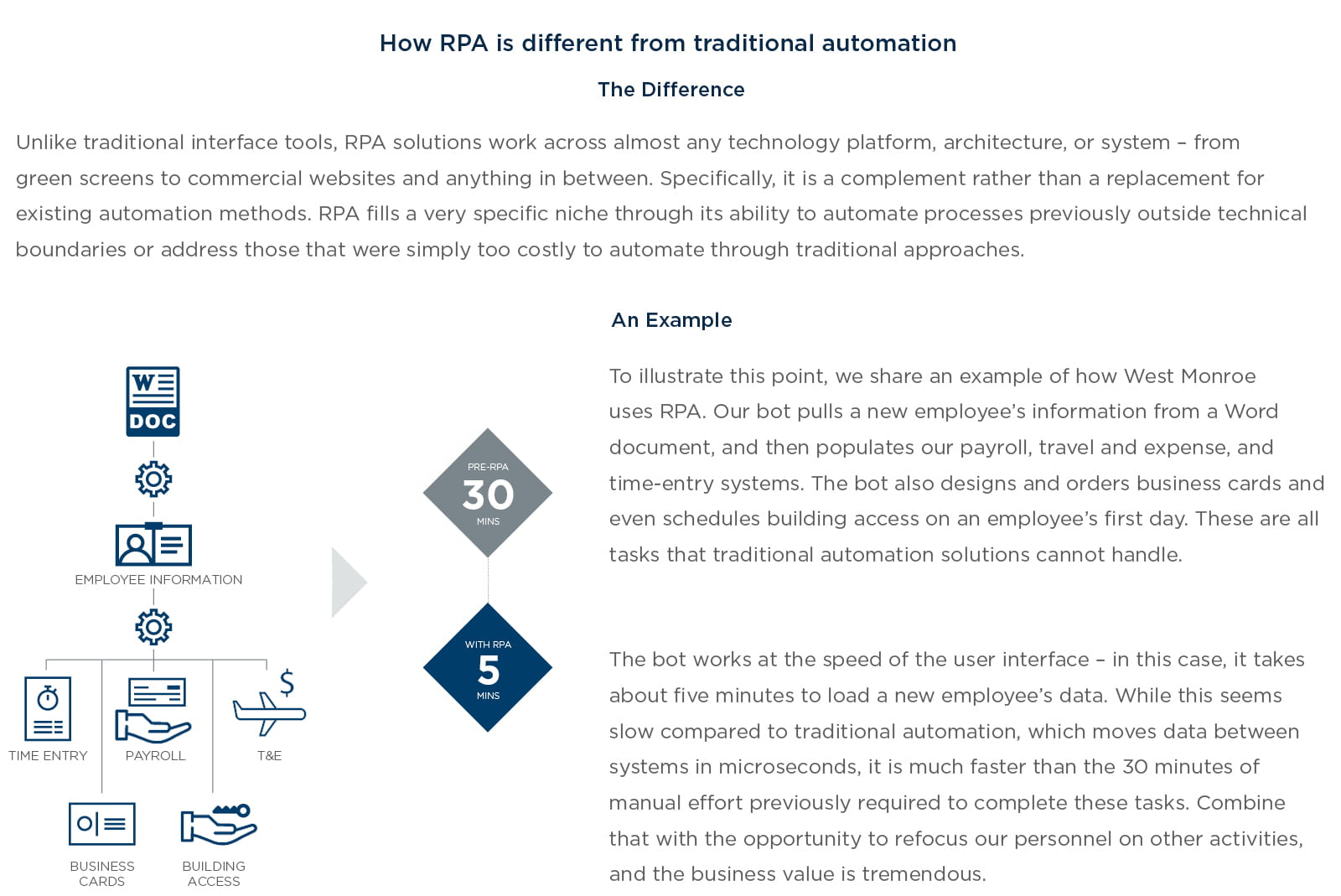
March 2018 | Point of View
Robotic process automation: It’s impossible to start ‘change’ too soon
Robotic process automation: It’s impossible to start ‘change’ too soon
Executives are balancing investments in modern, customer-facing technology with aging back-office systems. While both are necessary to keep operations going today, the problem lies in connecting the systems together – and this process often requires manual work from humans, which frustratingly erodes the value of the technology.
Organizations struggling with this issue stand to gain significant benefits from robotic process automation (RPA) – a class of evolving technology tools that create interfaces between systems more efficiently and complete tasks previously performed by people.
However, many organizations have been slow to leverage RPA. One of the key challenges is the scope of organizational change required, often broader than most technology projects. Add to that the news media’s focus on potential job losses from RPA, and many executives are afraid to approach this technology out of concern for morale and resistance. But the fact is, RPA should not be ignored if executives want their organizations to realize value from their growing technology investments.
RPA should not be ignored if executives want their organizations to realize value from their growing technology investments. ”
RPA is changing how organizations think and operate
Robotic process automation (RPA) is attracting significant attention, spurred by the growing buzz in business and technology circles. Indeed, it is a fast-growing market: The robotic automation market will grow from $250 million in 2016 to $2.9 billion in 20211.
One challenge, of course, is where to start. In many organizations, adoption of RPA typically starts with experimentation in one part of the business. The first project is a proof of concept or pilot involving a manual process where an individual is “swiveling” between two or more systems, entering the same data repeatedly. For a bank, this might involve interfacing systems used to support clients’ treasury management needs or moving customer loan onboarding information into core systems in a timely and accurate manner.
Finding the right starting point and establishing a proof of concept or pilot that can demonstrate the value and potential of RPA is important. But even more important than identifying that first process to automate is the organizational change aspect of RPA – moving past internal resistance and roadblocks in order to execute that successful first project. Indeed, change management should begin before making strategic decisions about how and where to employ RPA within operations.
In addition to changing “who” performs work, the technology is also forcing adopters to rethink organizational structure, skill requirements, metrics, rewards, and even technology governance. Given this level of change, when starting down the path toward integrating RPA into operations, executives should have a well-conceived change management approach – one that starts far earlier and employs different tactics than the institution may use for more typical technology projects. In other words, this may not be your classic CRM or ERP system implementation project.
RPA is a different type of automation
While RPA sounds revolutionary, in reality it is more evolutionary – an amalgam of long-existing technologies. Think of RPA as a single component of the automation lifecycle. When you can’t interface two systems or need to push data across multiple systems, RPA can be the answer. It doesn’t replace existing automation tools. Rather, it automates the processes that existing tools cannot.
The term “robotic process automation,” and specifically the word “robot,” has become a double-edged sword for the technology. It is both a leading-edge concept that excites businesses for its potential and a lightning rod for media interested in automation’s potential impact to society.
Some reports state that RPA will eliminate millions of jobs. However, for all the reasons stated above, we don’t believe that to be true. Its applications are limited to highly repetitive, consistent tasks that are performed manually today. In many situations, RPA’s value comes from error reduction or speed to revenue rather than cost savings. While applying RPA to these tasks can produce significant value, its near-term impact is far from redefining society.
And, while much of the conversation has centered on the cost-reduction opportunities of replacing human- performed tasks with robots, many organizations are finding robots can add value to employees’ roles vs. replacing them. For example:
- “Backup” Coverage – Working 24/7, without getting sick, taking vacations, or even lunch breaks
- Handling some tasks faster than people working manually
- Avoiding transposition or other data-entry errors altogether
- Freeing employees to handle higher-value tasks
It is important to consider prevailing perceptions as you move into the world of RPA – but don’t allow them to define and lead your approach.
Understand and address concerns of each key constituent
Traditionally, when implementing new technology that alters the way people work, organizations will plan for the changes alongside development and execute communications, training, and other tactics as the new systems “go live.”
Change management around RPA requires a different approach. Given the unfamiliar technology (a robot vs. a known system like new accounting software), lack of clear understanding, and all the attendant hype, change management becomes a full-time job – from the initial discussions to well past the go-live point.
Key Constituent Considerations
The following material briefly outlines each of these stages, including typical scenarios, changes faced, common challenges, and tips for developing effective messaging. Taking this type of approach allows executives to hear, understand, and address the concerns of various constituents who are crucial to successful adoption.
Engaging leadership in discussions about introducing RPA
Leadership engagement is a core component of change management, and it will never be more important than it is when introducing RPA. Across the organization, perceptions will range from excitement to fear – and sometimes a mix of both. Initial education followed by active coaching will be critical to success as executives help introduce RPA to their organizations.
A typical scenario: Executives are both enamored with the potential for RPA to produce business benefits and fearful of employees’ reaction to it. They may find it more difficult than usual to “pull the trigger.”
Changes faced: Leaders must understand the possibilities and impacts of RPA and then make confident decisions to move forward.
Common challenges: One of the most critical challenges is leaders’ willingness to communicate openly with employees, given potential perceptions about job loss.
Messaging tips: As is the case with many change initiatives, open and honest conversation can help overcome concerns. The focus should be on equipping executives to cut through the hype and talk openly with employees about what RPA is and is not, why the organization is introducing it, and, most importantly, how they see it affecting people and work. Often, this type of open communication promotes more curiosity and engagement than fear.
Involving department leads: The IT function
Although early RPA pilots may not require IT involvement, including IT early in the process will pay dividends in the long-term.
A typical scenario: IT leaders may be familiar with RPA but may not understand how implementing and managing it differs from technology currently in the organization’s “stack.”
Changes faced: Business users can typically implement and run RPA pilots with little support from technologists. But as RPA gains traction and use within the organization, the IT function will need to come to terms with changes or additions to its governance structure. As a result, they can become a major barrier in the jump from pilots to a larger robotic workforce.
Common challenges: Early on, IT organizations may be uncomfortable pushing forward with a proof of concept without conducting a full vendor evaluation– particularly since many RPA vendors are newer companies and not as familiar. As more processes are automated, IT will need to allocate servers, assign support resources, and even adjust governance structures to support RPA overall.
Messaging tips: Encourage an active partnership during initial RPA initiatives – inviting IT to be involved while allowing business units freedom to explore what is possible through limited proof-of-concept or pilot projects. As early projects realize value and use of RPA expands, encourage the IT function to take a more active role in making RPA scalable and secure.
Involving department leads: The HR function
The most obvious impact of RPA is on employees’ roles and jobs. Accordingly, it is important to engage the HR function early to assess and prepare for potential changes.
A typical scenario: HR leaders may have heard of RPA, but they may not recognize that their function plays a key role in implementing and supporting it.
Changes faced: The HR function will need to support both employee and technology changes. Implementing RPA will typically change employee roles – for example, shifting from data entry to other roles such as managing the bots or performing customer-facing functions. The HR function, therefore, must participate in identifying and planning for these changes and helping employees through the transition. This may involve changing position descriptions and performance criteria and potentially even compensation and organization structure.
In many cases, organizations will need to “badge” bots as employees so that they can access and manipulate various operational system. This, too, requires consideration and involvement from the HR function, including new processes to manage bots as employees. Eventually, the HR function itself may begin to employ RPA technology within its own processes.
Common challenges: HR organizations must come to terms with the concept of bots working as badged employees.
Messaging tips: Aim to educate HR leaders first about the value and impact of RPA and then encourage active partnership as the organization begins to explore initial RPA initiatives.
Involving department leads: Operational department leaders
This step will be similar to approaching executive leaders, although at a more tactical level. Department leaders can be gatekeepers, both for assessing RPA opportunities and for implementing the technology. Education and coaching are crucial to maintaining momentum and engaging operational departmental leaders is critical in preparing the organization for change.
A typical scenario: Departmental leaders may have heard of RPA, but they may not recognize their key role in implementing and supporting it – i.e., it’s not just IT’s “thing.”
Changes faced: RPA can change the way departments perform tasks or processes; it will require changes in roles and skills required and potentially areas such as performance management.
Common challenges: Like senior executives, department leaders may be reticent to communicate openly due to fears about employee reaction. Without their visible leadership, though, initiatives will struggle to gain traction or deliver on the potential.
Messaging tips: Encourage and equip department leaders to communicate openly and honestly with employees. Equip them with messaging that helps them cut through the hype and describe clearly what RPA is and will do for the organization.
Involving employees in bot analysis and design
In RPA deployments, it’s not unheard of for employees to stonewall or avoid “full truths” as a means of protecting their jobs. Open, transparent communication that begins early in the process is key to obtaining buy-in and cooperation.
A typical scenario: An organization asks employees to help it identify processes for automation, but in doing so, it offers them little context about RPA and its impact on people.
Changes faced: While the most familiar pre- conceived notion associated with implementing RPA is job elimination, the more common effect is changes in roles from manual tasks such as data entry to “knowledge” roles such as managing bots or handling exceptions.
Common challenges: A quick Google search will likely position RPA as “job threatening.” This may require more work to obtain employee buy-in.
Messaging tips: Begin educating employees early on about the value of adopting RPA, and respond quickly to concerns about job security and role changes. To build credibility, messages should come from both executives and operational department leaders.
Implementing, launching, and maintaining bots
Managing change for a bot implementation mirrors traditional change management approaches, focusing on building awareness, then understanding, then buy- in through communication, management training, and post-launch support. In this case, though, these traditional steps are just the basics. Post-launch communication will be just as critical – perhaps more than for other types of technology change. The more care that goes into defining, communicating, and supporting these changes, the easier the transition and the faster the path to achieving desired benefits.
A typical scenario: The organization introduces bots – and now the people who used to be data entry experts are responsible for managing exceptions as well as the bots themselves.
Changes faced: Individuals and organizations that oversee bots may face changing expectations and performance criteria, such as new service level agreements, volume requirements, communication patterns, and/or levels of decision-making authority. They also may be required to oversee the bots.
Common challenges: Employees must understand the changes in their role(s), as well as changes in expectations and then use that knowledge to work more productively. Defining and communicating the changes to roles upfront can be challenging, particularly for early pilot projects, when the organization has little experience as a guide.
Messaging tips: Define new expectations and success/performance criteria before launching the bots, and communicate with and train employees in advance. Where it makes sense, include the HR organization in identifying how the change will affect employees and engage it to help with adjusting organizational structure, job descriptions, and other changes.
Introducing RPA to new departments
It is often prudent to implement RPA one department at a time. Allow automation begin to take hold in one area, then start looking to other departments for opportunities to target. This may feel a bit like “starting over” with new executives or department leaders who will require education and support to get beyond the hype and focus on the potential value.
It is often prudent to implement RPA one department at a time. ”
A typical scenario: After realizing success in one department, an organization may begin looking for opportunities to use it in other departments.
Changes faced: Key changes will be similar to those of the original department leaders involved – that is, automation will affect roles, skills, and potentially performance management and structure.
Common challenges: Similarly, the challenges typically will revolve around reticence to communicate openly due to fears about employee reaction.
Messaging tips: When implementing RPA the second time around, organizations benefit from success stories that bolster their education and change management initiatives. These stories, told by advocates from other parts of the organization, will be the most powerful resource available for engaging new departments – both at the management and employee levels.
Expect the approach and messages to evolve over time
Upfront, ongoing, and broad change management is paramount to a successful foray into RPA. And, as RPA becomes better understood and more prevalent, the fear of a “robot workforce” will subside. As that happens, organizations can shift back to more traditional approaches to change management.
Until then, some institutions are creating centers of excellence and program management offices around RPA as their use of the technology gains enterprise focus. These organizations typically build in change management and communications responsibility.
In the meantime, organizations should be prepared to communicate, educate, and support stakeholders throughout the introduction of RPA. This is one case where it is impossible to start change management too soon.





.jpg?cx=0.5&cy=0.5&cw=910&ch=947&hash=A4606672548264CB35551B59CE1C1AC2)